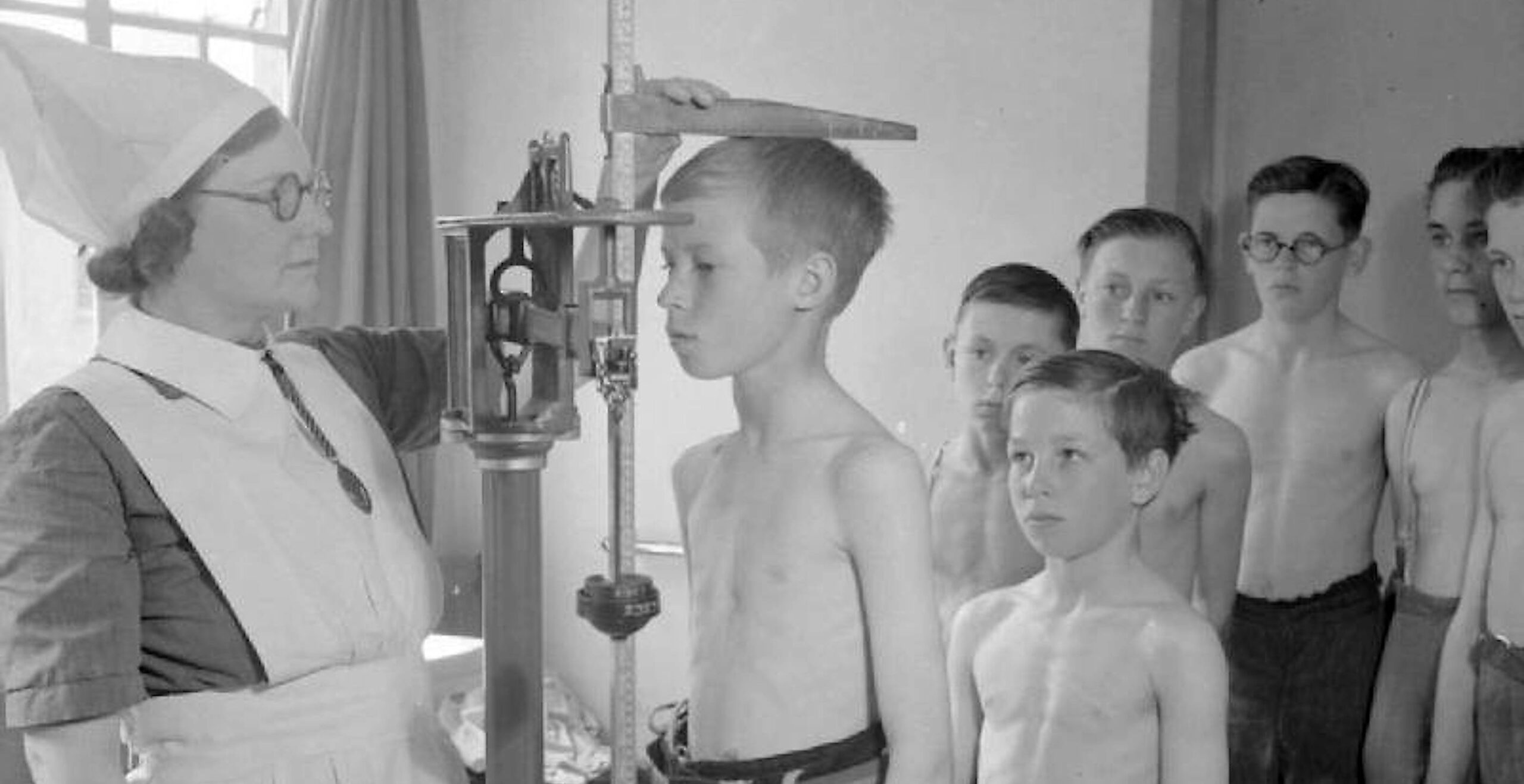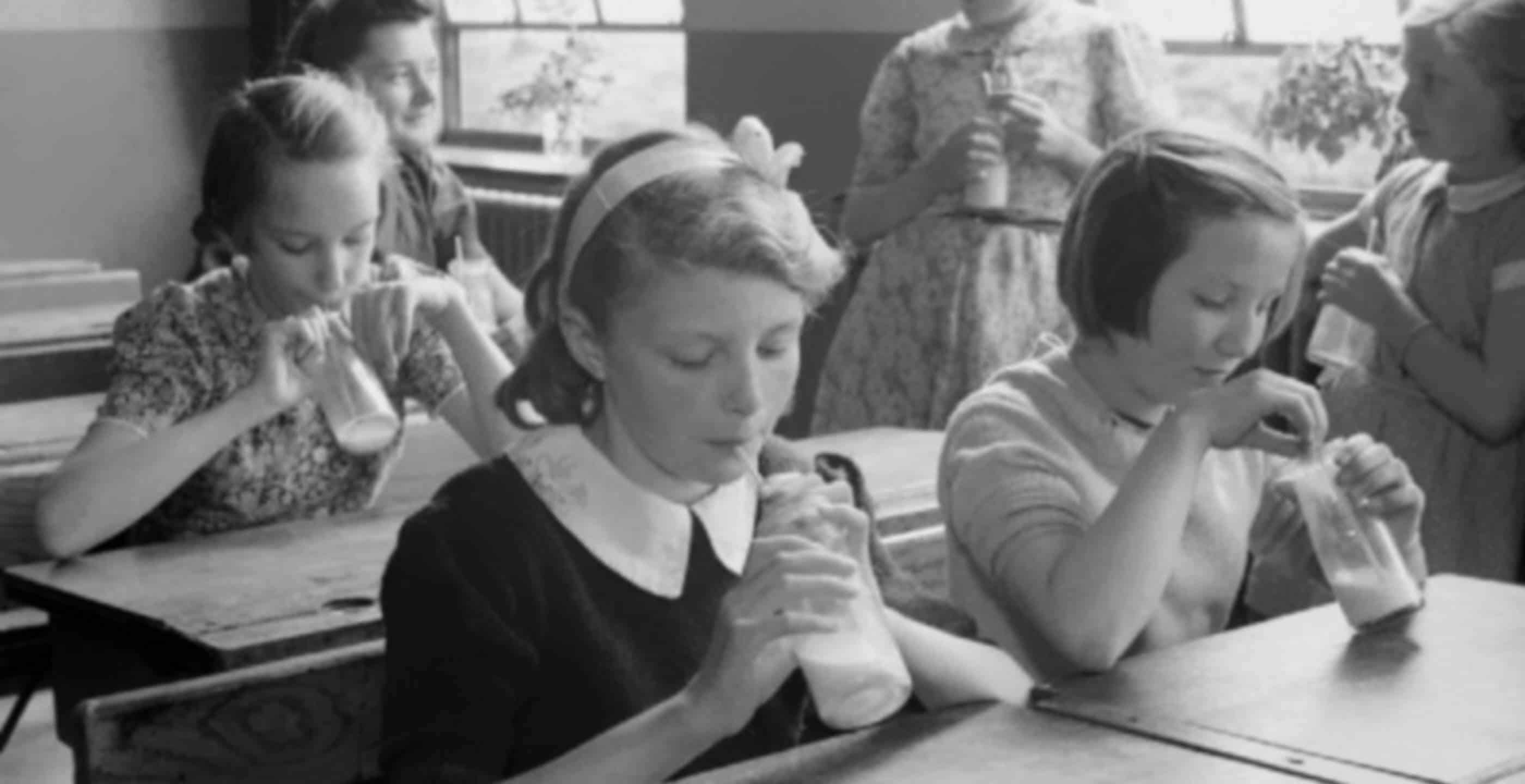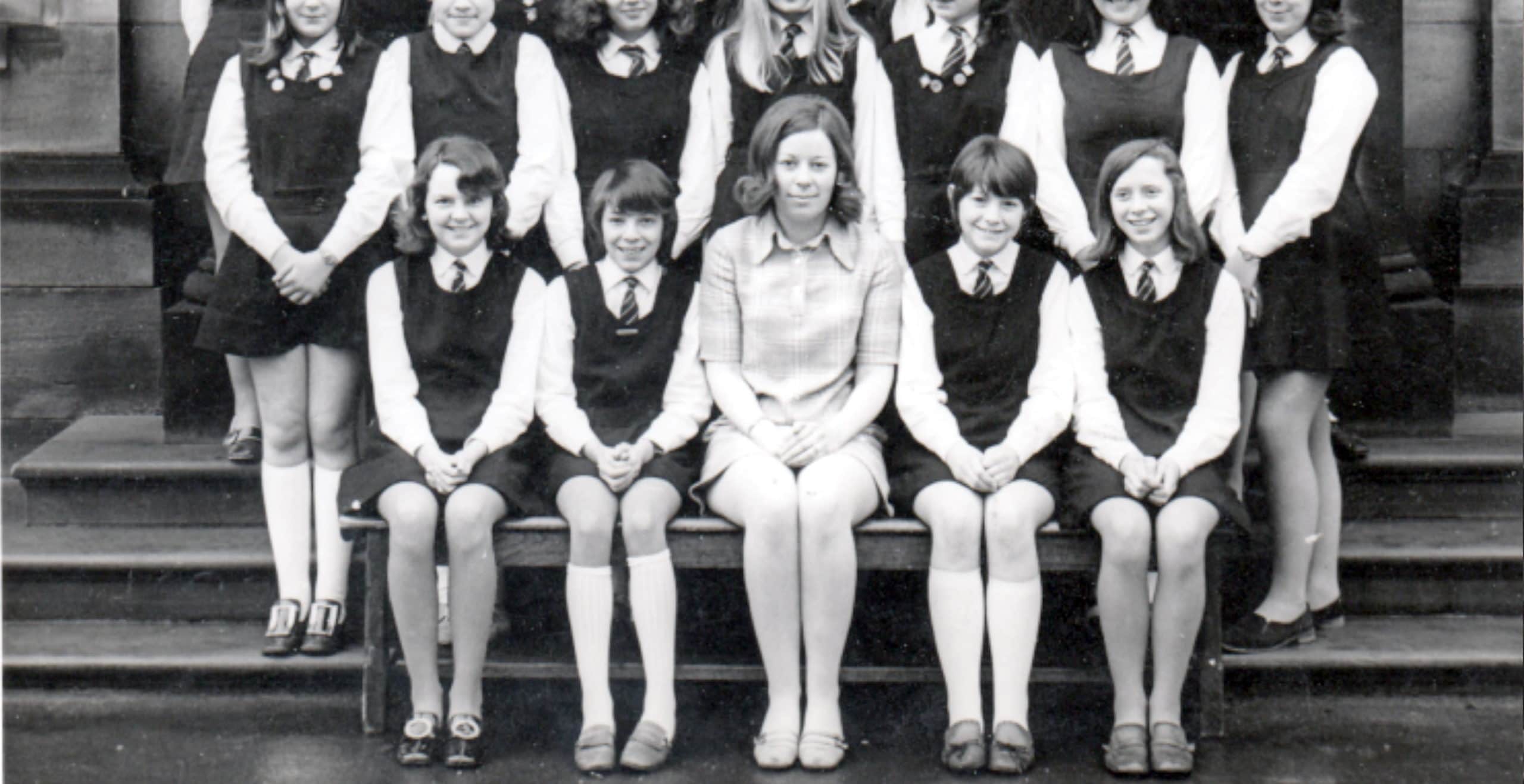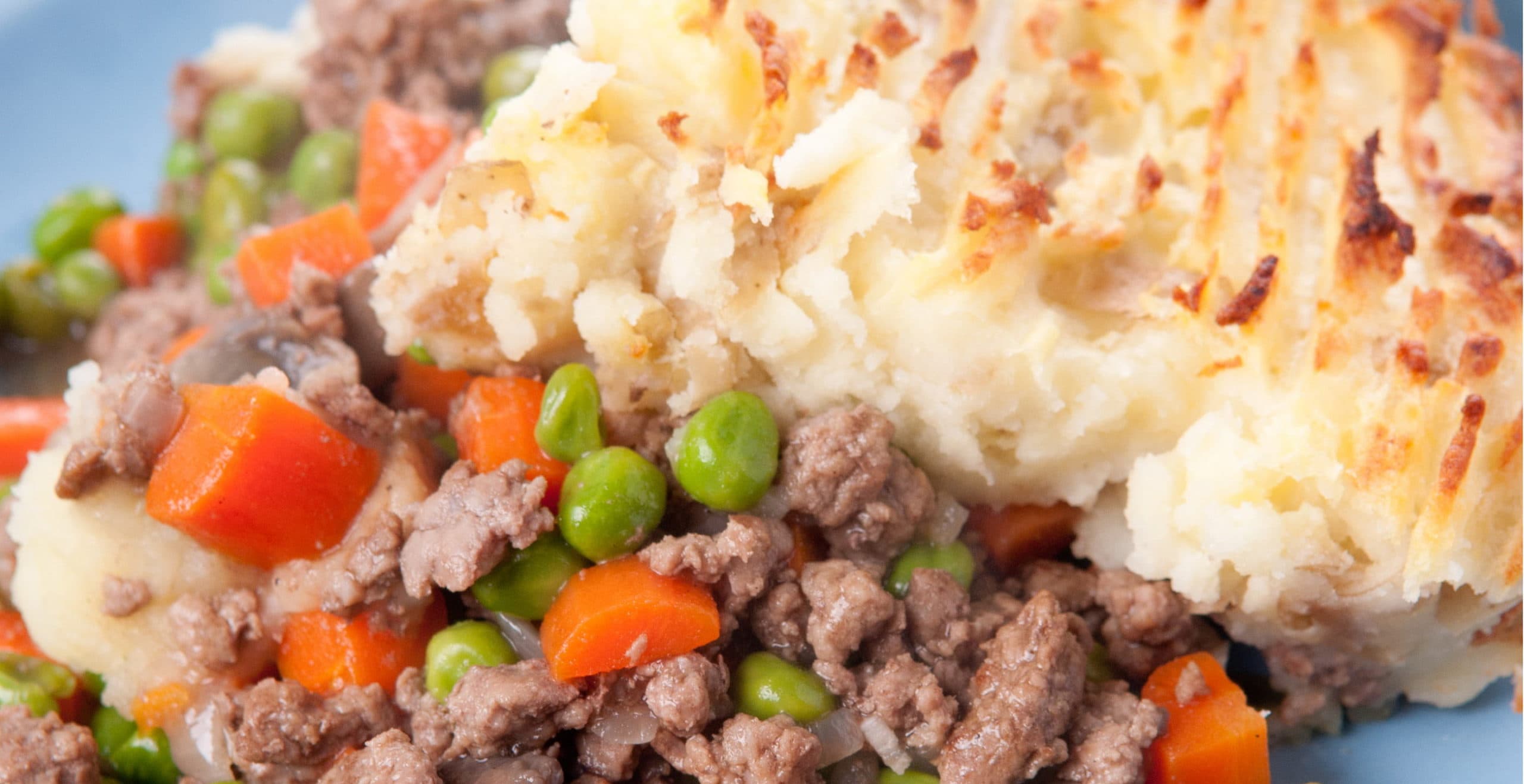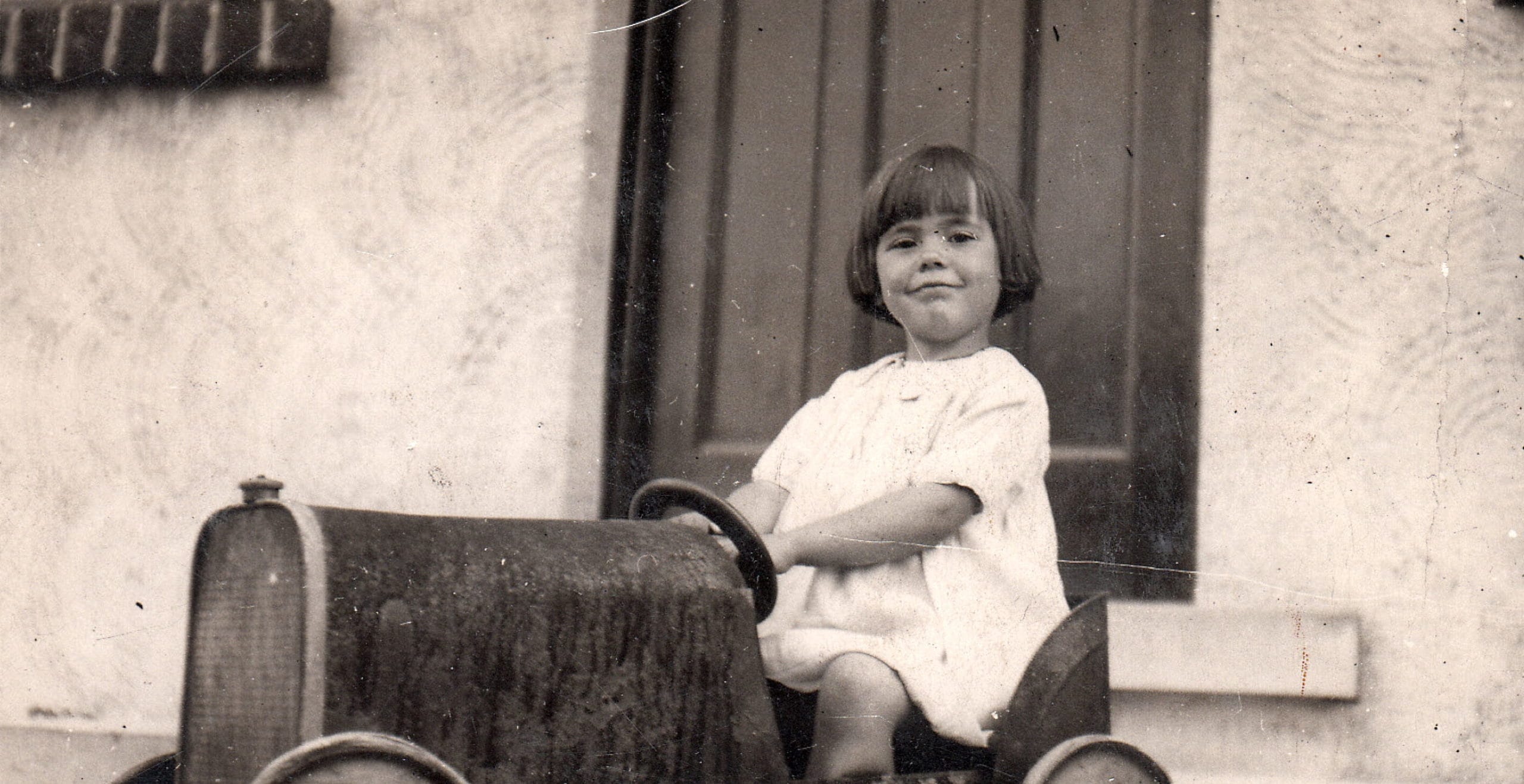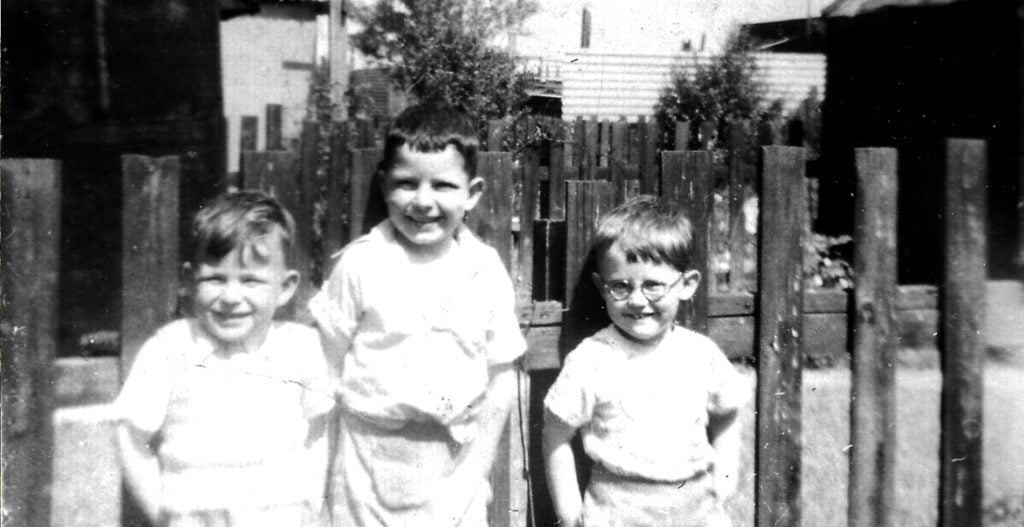Whether educated in a boarding school, grammar school, or secondary modern school, certain memories still cause shudders in the post-Second World War generation of British schoolchildren. School dinner tapioca with a blob of jam in it. Watery mashed potato and overcooked cabbage. For some, bread and dripping, while others relish the recollection. Being forced to perform gymnastics in the school hall in vest and pants to the accompaniment of plummy voices on the BBC Home Service (now Radio 4). Be a tree and sway in the breeze! Be a star, twinkling in the sky!
Then there were the inoculations, known as “jabs” or “jags”. There seemed to be so many of these that school day reminiscences conjure up a resigned-looking queue of children, sleeves rolled up to their shoulders, waiting outside the nurse’s room. The post-war generations were going to be healthy, by crikey, and glug down their daily third of a pint of milk, spoonful of cod liver oil, and rosehip syrup, even if it killed them!
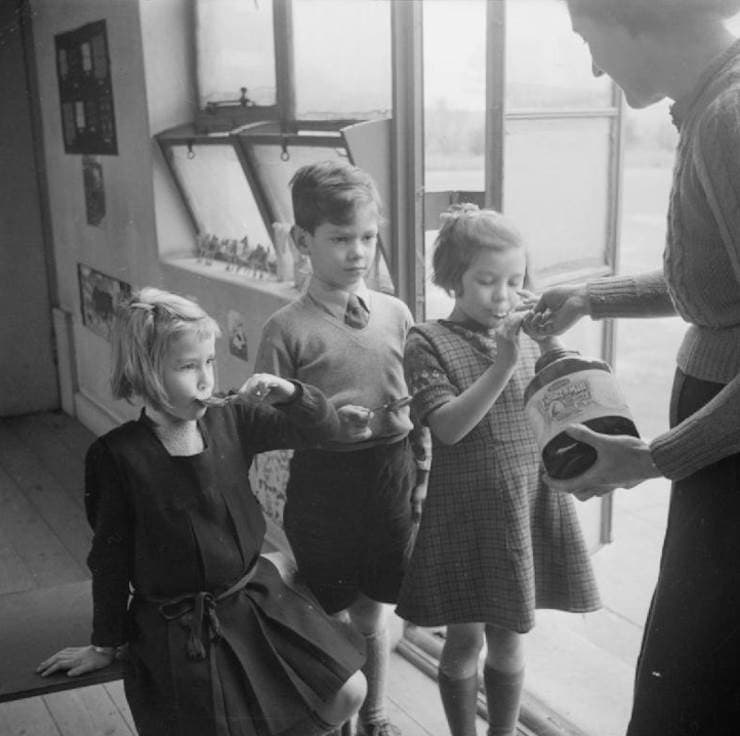
The ultimate Hammer Horror story for vulnerable schoolkids was, of course, the regular visit of the medical specialist known as the Nit Nurse. This was usually announced to a shocked school during school assembly. The sting was taken out of this terrifying visitation by whispers among the school population of “Nitty Nora the Bug Explorer!” Sniggering like the Bash Street Kids in the Beano comic reduced the sense of squirming shame that accompanied this part of the annual school routine.
There were many regional variations on this disparaging nickname. It’s flattering in a way. All the other medical staff turning up at school were simply “the doctor” or “the nurse”. Generations of children have had their hair and scalps explored by the probing fingers of the nit nurse. When did it all start?
Health care for the UK’s school-age population is a given now, but it wasn’t always the case. Two significant pieces of Liberal government legislation early in the twentieth century formed the basis for later health and education reforms. They were the Free School Meals act of 1906, intended to provide at least one good meal a day, plus milk, for every child. This provision was viewed as essential for less well-off children. The second was the Education (Administrative Provisions) Act 1907, which ordered that every local authority should set up a school medical service. 1912 saw the introduction of school clinics. It was proposed that every child should have at least three medicals during their school life.
Somewhat unnervingly, the school medical service had been influenced by the Interdepartmental Committee on Physical Deterioration (1904), the idea that society and individuals were in some way degenerating being an obsession of the times. However, this period also saw more enlightened provision for special needs children, ensuring standards of education, nutrition, health care, and physical activity for these students.
Prior to this, the focus was on education, not health, and interactions with the local doctor as part of the school day were rare. Earlier education acts in the 1870s concentrated on the provision of education to students in city, town, and country through local school boards.
There are many books of this period describing the schooldays of this generation, and few if any mention any medical inspections. There’s no reference to medical examinations, nits, or nit nurses in Lark Rise to Candleford by Flora Thompson (1876-1947), for instance, though she does describe her education, bathing in water boiled in the brewhouse copper, and the changing hair fashions of the times. The available biographical literature suggests that the basic rule for the less well-off was “cleanliness is next to godliness, and don’t get sick. Oh, and there are some things we just don’t talk about in this house, and n-i-t-s is one of them. Pass me that comb”.
For whenever anyone thinks of the School Medical Service, the topic of nits is never far away. Lice are right at home in human hair, which provides a comfy, warm gaff for them. Thus, head lice are the ones that are still prevalent among us and the ones that spread easily in school and other close-knit (pun intended) yet mobile communities. Strictly speaking, the term “nits” applies to the eggs of headlice, not the lice themselves, but it’s often used casually to describe the whole phenomenon of infestation.
Once, they were simply part of everyday life. Everybody and anybody could suffer from blood-sucking headlice; lord, lady, servant, monarch. Servants working in big houses knew what was required: if you’ve got ‘em, keep ‘em to yourself. The hair was kept under cover of hats, caps, or protective linen coverings known as coifs. As the cotton industry expanded in Britain, inexpensive, cool, easy-care cotton scarves became the fabric of choice to keep one’s head menagerie hidden from the master and mistress of the house.
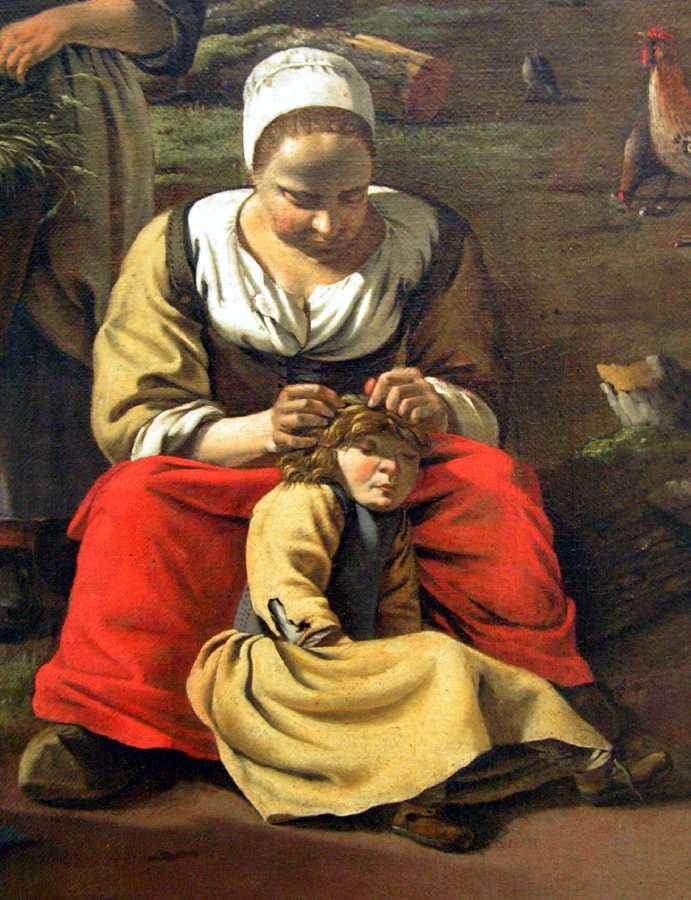
Shaved heads and wigs among the gentry may have reduced the phenomenon in their own class in the seventeenth and eighteenth centuries. The ancient Egyptians tackled head lice in the same way – head shaving and wigs – but they couldn’t eliminate them entirely, and desiccated lice and nits have been found in mummy hair. Perhaps one day an Egyptologist will discover the tomb of Lady Nit-nor-ah, the ancient Egyptian bug explorer.
It was the First World War that brought the topic of nits out of the cupboard. It wasn’t just the School Medical Service that was concerned about them. Karl Von Frisch (1886 – 1982) was Director of the Institute of Zoology in the University of Munich, and while his best-known work is on bees, he knew all about gnats, fleas, lice, bedbugs, ticks, and many more creepies and crawlies. His book Ten Little Housemates, in which he discusses the insects (with 70 drawings!) that share our homes (and bodies) is a classic of its kind.
If you’re not scratching by now, you soon will be. “A head louse has not the dash of a gnat, neither has it the temperament and jumping powers of the flea,” pronounces Professor von Frisch. “Not that it feels these deficiencies as it crawls sedately in the hair, for it has a special compensating equipment: strong claws on its feet (see illustration) and powerful muscles which allow it to stick its claws in and hold fast to the hairs … Generations of lice can find accommodation on one and the same head. They are models of clinging tenacity, persistent hangers-on.”
Citing examples of carriers with up to 16,000 head lice, von Frisch outlined the danger that lice posed. The main threat was deadly typhus, also known as “the prison disease,” which resulted from inhaling the dust from lice droppings. “Lice also carry other, less common, fevers and plagues (relapsing fever, trench fever, five day fever etc.).” So taking practical steps against head lice really has origins in managing both prisons and military populations. Combine this with the concern of mid-late nineteenth scientists and philanthropists over water and air quality, and the stage was set for a major clean-up of the environment and human bodies, with schools in the front line.
Von Frisch knew how to deal with nits, too. Prussic (hydrocyanic) acid. Yes, really, probably one of the most deadly gases known to humanity: “If fumigation was carried out efficiently not a single louse-egg had any chance of surviving. People were only too glad also to smoke bugs out of hidden crevices in living rooms.” However, “Now, nobody will launch a poison gas attack because of a few head lice. Indeed, it would scarcely be advisable to do so as long as they are on our heads.”
Quite. As an alternative and less lethal home remedy, the professor suggests vinegar or petroleum (in this case, paraffin) well rubbed into the scalp. Give the clothes, especially underwear, a good scrubbing in hot water with carbolic soap and spray or dust your head with the twentieth century blessing that is DDT. Eek! However, what the professor didn’t know was that the British had a secret weapon: Nitty Nora! An army of nurses tackling those head lice with gusto, wielding their trusty nit combs, also known as dickey combs.
In the early decades of the twentieth century in working-class areas, despite the education acts, head lice appear to have been mostly controlled by a mixture of combing, avoidance, and threat. William Woodruff’s biography The Road to Nab End describes growing up, often in dire poverty, in a mill town in Lancashire. On his first day at school, his sister explained how to avoid infestation as soon as he reached the cloakroom: “Because of the occasional outbreak of head lice, Brenda had told me to keep my cap separate from the others.”
Classroom decoration included “A large Lever Brothers Lifebuoy Soap poster, which covered most of the wall at my side. It showed a bar of lathered Lifebuoy Soap with a finger that pointed at me. Beneath the finger in great letters were the words WHERE THERE’S DIRT, THERE’S DANGER!” Woodruff, seated right in front of the poster, “took it personally…my neck was no dirtier than any of the others…I think we believed in being comfortably dirty”. While he describes his mother cracking bedbugs on the hems of the bedsheets, he does not describe the other weekly ritual familiar to working-class children at that time, bending over a sheet of newspaper to shake out the lice onto it and have their hair combed through for good measure.
One North Shields resident recalls the experience with a shudder on the “Remembering the Past” website: “After we were in our night gear and glowing red from being scrubbed with carbolic soap, we waited our turn for the dreaded dickey comb which is a fine small toothcomb. When your turn came you knelt down in front of your mam with your head bent down over a newspaper”. The relief when nothing was found; the uproar and stigma after a positive identification!
Rank had few privileges when it came to nits, or indeed school medical examinations. One contributor to Arthur Marshall’s book on life in public schools for girls in the twentieth century (Giggling in the Shrubbery) recounted that “On returning to school after the holidays, we were subjected to a vigorous health inspection. This was not a very flattering reflection on our homes. First our hair was scraped through for nits and until we had ‘stripped to the waist with shoes and socks off’ and been examined, we were not considered worthy to be accepted back into the fold”.
Bemoaning the state of her greasy hair, another described controlling the oiliness with talcum powder rubbed well in: “Interestingly enough it was practically unheard of for any of our dirty heads to be hosts to parasites. They obviously didn’t fancy us much either”. A third former pupil described having her head dunked heartily in a basin to have her hair washed with Icilma shampoo: “It seeped into the eyes and was breathed in by the nostrils, but we were not allowed flannels as protection”.
Between the two world wars, Labour local government maintained and built on the medical provision granted to schools by the Liberal education acts. Local authorities focussed particularly on maternity and childcare. It worked, too. The well-kept statistics of the period show a marked increase in health, and perhaps surprisingly, in height, even in the 1940s.
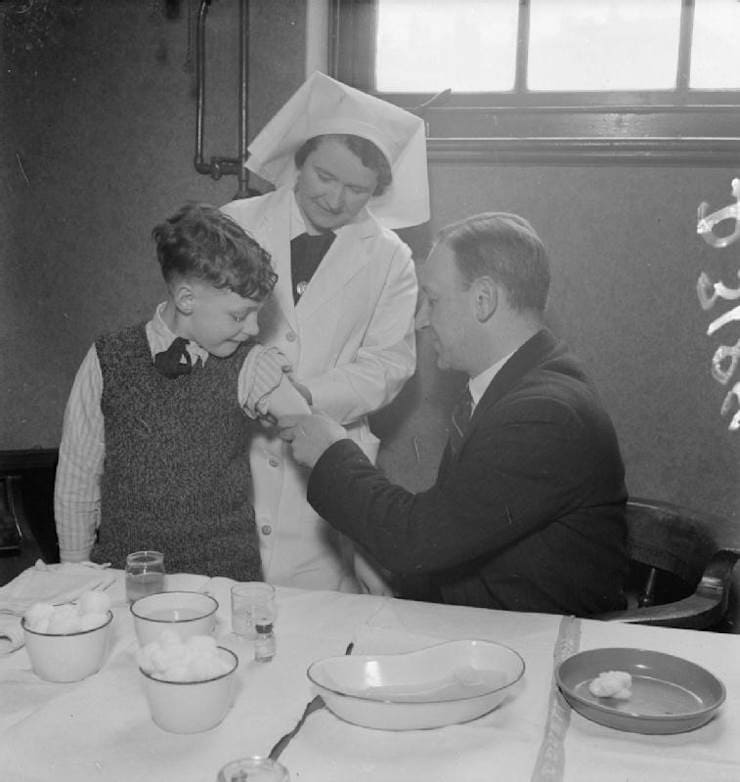
Following a severe outbreak of poliomyelitis in the early 1950s, routine vaccinations against diseases that had once been fatal or seriously harmful to children – polio, tuberculosis, diphtheria, measles, and pertussis (whooping cough) – were provided through the School Medical Service, now working alongside the NHS. Indeed, the ethos of the School Medical Service provided inspiration for the NHS. It was also the period after the Second World War that saw the real march of the nit nurse army in the UK, probably driven by a peak in nits during the 1940s.
The 40s infestation, combined with the launch of the National Health Service, meant that nits were no longer an individual problem or left to the vagaries of schools and local health boards, but firmly in the sights of national government health targets along with other medical interventions. The generations of the later fifties and throughout the sixties remained largely healthy and nit-free as a result.
By the start of the hippy 1970s, the world was wild about both long hair and shampooing, and more laid back about classroom life. Nits and childhood diseases no longer seemed to be a problem. Local Education Authorities worked with the NHS and other organisations such as the Schools Council and Health Education Council to ensure that children and young people continued to receive regular medical examinations and health education. Dental care was also an important aspect, with routine checks.
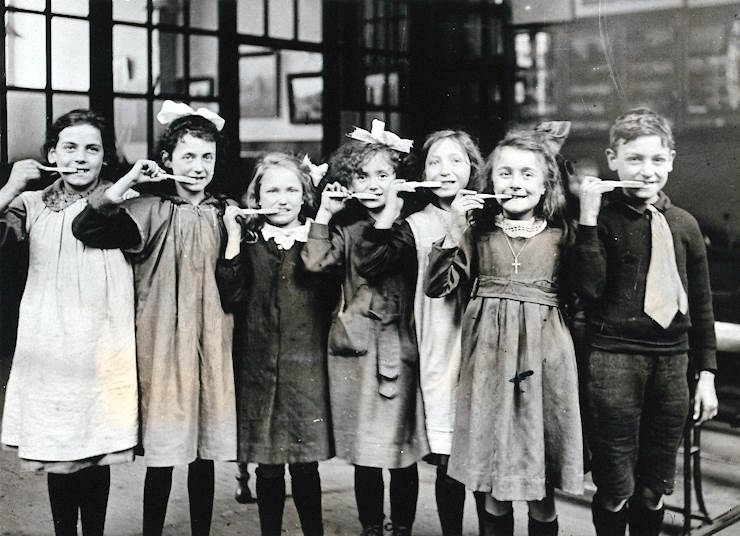
Over the next few decades, while other medical examinations and inoculations remained, the nit nurse slowly faded out, a relic of the past when it was acceptable to subject individual children to whatever embarrassing treatment was required in the cause of the greater good. In 1998, the BBC reported that nit nurses “were a regular part of school life for generations of children in the UK, but health professionals now take a dim view of regular head lice checks. Dundee Healthcare Trust is the latest in a long line of health agencies to abandon what it describes as the ‘embarrassing and humiliating’ practice of subjecting pupils to hair examinations by school nurses”.
Ominous warnings about an epidemic of nits followed. Nits had certainly not gone away. Batting the objections back into the home, the schools pointed out that the 1996 Education Act meant it was a criminal offence for parents to allow children to be repeatedly infected. Parents returned the volley to the schools, and by the early 2000s were calling for the return of the school nit nurse. A plethora of insecticidal remedies hit the supermarket shelves, with the voices of doctors pointing out in vain that statistical evidence proved that old-fashioned treatments of regular combing, shampoo, and conditioner were much more effective than harsh chemicals.
Today the situation seems to have reverted to earlier times; a problem we don’t like to talk about. The giant head louse is in the corner of the room, and who, precisely is responsible for ejecting it?
Nit nurses, of course. They’re back, and the nit nurse is now a global phenomenon. My husband, growing up in Sydney, Australia in the 60s and 70s, had never heard of nits, or the nit nurse. “I thought head lice were a thing of the past, along with typhus,” he commented, bemused. I’ve had to break it to him that Oz now has nit nurses, and they have their own websites. As any other medical professional, they’re proud of the service they provide, not ashamed of it.
Controversy also arose in the 2000s over universal inoculation programmes. The anti-vax movement would have seemed odd to earlier generations. Having lived through epidemics that had seen children die from whooping cough, measles, or scarlet fever, or be confined to iron lungs or require callipers through polio, universal inoculation programmes in school seemed to be a blessing. Even the stark warning of the Thalidomide programme had not dented the general belief that most medical interventions were positive.
Whatever the future brings for school children, hopefully one aspect of health care is now a footnote in history: shame. When it came to nits, according to the anonymous North Shields correspondent, “Even the teachers would treat those children affected as if they had some contagious disease”. The irony is that like all parasites, nits aren’t fussy. They don’t care whether their hosts live in a mansion or a caravan, are aristocrats or street-sweepers. They’ll live on anyone. Blast them with chemicals and they’ll regroup and come back. It’s likely the nit nurse won’t be disappearing any time soon, either!
Dr Miriam Bibby FSA Scot FRHistS is a historian, Egyptologist and archaeologist with a special interest in equine history. Miriam has worked as a museum curator, university academic, editor and heritage management consultant.
Published: 21st April 2024
